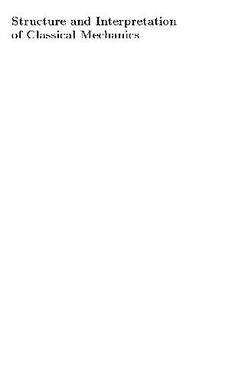Table Of ContentStructure and Interpretation
of Classical Mechanics
Structure and Interpretation
of Classical Mechanics
Gerald Jay Sussman and Jack Wisdom
with Meinhard E. Mayer
The MIT Press
Cambridge, Massachusetts London, England
(cid:176)c2000 by The Massachusetts Institute of Technology
All rights reserved. No part of this book may be reproduced in any form or
by any electronic or mechanical means (including photocopying, recording,
or information storage and retrieval) without permission in writing from the
publisher.
This book was set by the authors using the LATEX typesetting system and
was printed and bound in the United States of America.
This book is dedicated,
in respect and admiration,
to
The Principle of Least Action.
\The author has spared himself no pains in his endeavour to
present the main ideas in the simplest and most intelligible form,
and on the whole, in the sequence and connection in which they
actually originated. In the interest of clearness, it appeared to
me inevitable that I should repeat myself frequently, without pay-
ing the slightest attention to the elegance of the presentation. I
adhered scrupulously to the precept of that brilliant theoretical
physicist L. Boltzmann, according to whom matters of elegance
ought be left to the tailor and to the cobbler."
Albert Einstein, in Relativity, the Special and General Theory,
(1961), p. v.
Contents
Contents vii
Preface xiii
Acknowledgments xvii
1 Lagrangian Mechanics 1
1.1 The Principle of Stationary Action 4
1.2 Conflguration Spaces 9
1.3 Generalized Coordinates 11
1.4 Computing Actions 16
1.5 The Euler-Lagrange Equations 26
1.5.1 Derivation of the Lagrange Equations 27
1.5.2 Computing Lagrange’s Equations 34
1.6 How to Find Lagrangians 37
1.6.1 Coordinate Transformations 44
1.6.2 Systems with Rigid Constraints 48
1.6.3 Constraints as Coordinate Transformations 60
1.6.4 The Lagrangian is Not Unique 62
1.7 Evolution of Dynamical State 67
1.8 Conserved Quantities 76
1.8.1 Conserved Momenta 76
1.8.2 Energy Conservation 78
1.8.3 Central Forces in Three Dimensions 81
1.8.4 Noether’s Theorem 84
1.9 Abstraction of Path Functions 88
1.10 Constrained Motion 93
1.10.1Coordinate Constraints 95
viii Contents
1.10.2Derivative Constraints 102
1.10.3Non-Holonomic Systems 106
1.11 Summary 109
1.12 Projects 110
2 Rigid Bodies 113
2.1 Rotational Kinetic Energy 114
2.2 Kinematics of Rotation 116
2.3 Moments of Inertia 118
2.4 Inertia Tensor 121
2.5 Principal Moments of Inertia 123
2.6 Representation of the Angular Velocity Vector 125
2.7 Euler Angles 128
2.8 Vector Angular Momentum 132
2.9 Motion of a Free Rigid Body 134
2.9.1 Computing the Motion of Free Rigid Bodies 136
2.9.2 Qualitative Features 138
2.10 Axisymmetric Tops 144
2.11 Spin-Orbit Coupling 152
2.11.1Development of the Potential Energy 152
2.11.2Rotation of the Moon and Hyperion 156
2.12 Euler’s Equations 163
2.13 Nonsingular Generalized Coordinates 168
2.14 Summary 177
2.15 Projects 177
3 Hamiltonian Mechanics 179
3.1 Hamilton’s Equations 181
3.1.1 The Legendre Transformation 189
3.1.2 Hamiltonian Action Principle 199
3.1.3 A Wiring Diagram 201
3.2 Poisson Brackets 203
Contents ix
3.3 One Degree of Freedom 206
3.4 Phase Space Reduction 208
3.4.1 Lagrangian Reduction 218
3.5 Phase Space Evolution 220
3.5.1 Phase Space Description is Not Unique 222
3.6 Surfaces of Section 224
3.6.1 Poincar¶e Sections for Periodically-Driven Systems 225
3.6.2 Computing Stroboscopic Surfaces of Section 231
3.6.3 Poincar¶e Sections for Autonomous Systems 232
3.6.4 Non-axisymmetric Top 245
3.7 Exponential Divergence 246
3.8 Liouville’s Theorem 250
3.9 Standard Map 259
3.10 Summary 262
3.11 Projects 263
4 Phase Space Structure 265
4.1 Emergence of the Mixed Phase Space 266
4.2 Linear Stability of Fixed Points 271
4.2.1 Equilibria of Difierential Equations 271
4.2.2 Fixed Points of Maps 275
4.2.3 Relations Among Exponents 277
4.3 Homoclinic Tangle 282
4.3.1 Computation of Stable and Unstable Manifolds 287
4.4 Integrable Systems 289
4.5 Poincar¶e-Birkhofi Theorem 296
4.5.1 Computing the Poincar¶e-Birkhofi Construction 301
4.6 Invariant Curves 303
4.6.1 Finding Invariant Curves 306
4.6.2 Dissolution of Invariant Curves 311
5 Canonical Transformations 317
5.1 Point Transformations 318
5.2 General Canonical Transformations 322
x Contents
5.2.1 Time-independent Canonical Transformations 325
5.2.2 Symplectic Transformations 330
5.2.3 Time-Dependent Transformations 333
5.2.4 The Symplectic Condition 336
5.3 Invariants of Canonical Transformations 338
5.4 Extended Phase Space 345
5.4.1 Poincar¶e-Cartan Integral Invariant 352
5.5 Reduced Phase Space 353
5.6 Generating Functions 358
5.6.1 F1 Generates Canonical Transformations 360
5.6.2 Generating Functions and Integral Invariants 362
5.6.3 Classes of Generating Functions 368
5.6.4 Point Transformations 370
5.6.5 Classical \Gauge" Transformations 386
5.7 Time Evolution is Canonical 391
5.7.1 Another View of Time Evolution 397
5.7.2 Yet Another View of Time Evolution 401
5.8 Hamilton-Jacobi Equation 403
5.8.1 Harmonic Oscillator 405
5.8.2 Kepler Problem 409
5.8.3 F2 and the Lagrangian 413
5.8.4 The Action Generates Time Evolution 414
5.9 Lie Transforms 416
5.10 Lie Series 422
5.11 Exponential Identities 430
5.12 Summary 432
6 Canonical Perturbation Theory 435
6.1 Perturbation Theory with Lie Series 436
6.2 Pendulum as a Perturbed Rotor 438
6.2.1 Higher Order 446
6.2.2 Eliminating Secular Terms 448
6.3 Many Degrees of Freedom 451
6.3.1 Driven Pendulum as a Perturbed Rotor 454

